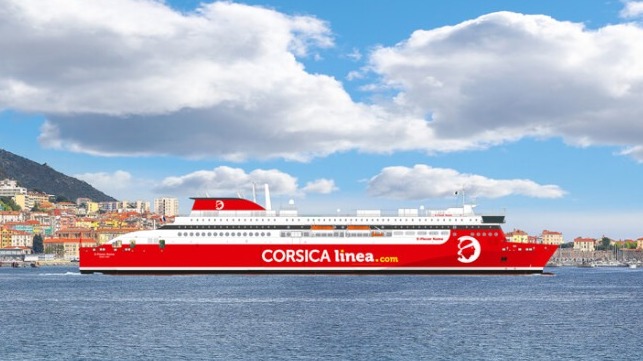Stena Expands E-Flexer RoPax Class with First Vessel for Mediterranean

The successful RoPax E-Flexer class is being increased with the first vessel designed for operation in the Mediterranean ordered. The class is a unique concept for larger vessels than the standard RoPax ferry, designed to be flexible and environmentally friendly.
Stena Line reports an order has been placed for the thirteenth vessel of the class. The design is being further refined and adapted for long-term operation by Corsica Linea. It will be the first of the class delivered into the Mediterranean region. Like the earlier vessels of the class, the new ship will be built by the Chinese shipyard CMI Jingling (Weihai) and is scheduled for delivery in the first quarter of 2026.
The E-Flexer ferry for Corsica will be 666 feet (203 meters) in length. It will have a capacity for 1,000 passengers and 2,500 cargo meters of freight. When introduced it will operate between Marseille, France and Corsica.
Stena Line introduced the E-Flexer class in 2019 and 2020 with two ferries operating in the Irish Seas. So far, a total of nine have been delivered with other vessels operating for Brittany Ferries and DFDS under long-term charter.
Each ship is tailored to the customers' needs, both commercially and technically. Optimized design of the hull, propellers and rudders helps to ensure that the E-Flexer vessels are at the forefront when it comes to sustainability, performance, and cost. The first five vessels were built with standard propulsion which was later adapted starting with the sixth vessel, which operates for Brittany Ferries, with LNG fuel options. The length of the vessels varies based on the intended deployment and the size ranges from 38,000 to approximately 45,000 gross tons.

The next member of the class is being built for Corsica and will use LNG and be equipped for battery power (Stena)
Commenting on the next vessel of the class, Per Westling, Managing Director, Stena RoRo said, “This ship is a further development of our previous RoPax concepts, where the focus on sustainability and future-proofing has been a top priority. Through the further development and optimization of the hull shape in combination with multi-fuel engines and battery hybrid technology, ordering new vessels will be the most important and powerful measure to reduce CO2 emissions from shipping in the future".
The vessels' engines are of the multi-fuel type and can run on LNG, conventional marine fuel (MGO), or biodiesel. The vessels have been designed in line with future environmental requirements and, through their technical design, can meet both existing and future international requirements by a wide margin. The vessels will be designed with the classification society notation "Battery power" which means that in the future the vessels will also be able to utilize batteries as a means of propulsion.

that matters most
Get the latest maritime news delivered to your inbox daily.
The first of the next iteration of the class with the battery capabilities is a ferry for Marine Atlantic, which will be operating in Canada running between Newfoundland and Nova Scotia. When the vessels were ordered in 2021, Stena described the adaptation as being equipped with a large battery hybrid package for energy consumption of 10 MWh for propulsion and maneuvering in port. They said the vessels would also be equipped with an 8 MW electric shore connection for charging the batteries. The large battery capacity enables speeds up to 17.5 knots on battery power alone.
With the addition of the vessel for Corsica, a total of four E-Flexer RoPax are under construction in China with one for Marine Atlantic and two for Brittany Ferries. Stena also has two New Max design vessels on order at CMI Jinling. The second class is a smaller hybrid freight RoRo also initially designed for the Irish Sea like the E-Flexer class. The first New Max is due to be introduced in the fall of 2025.
